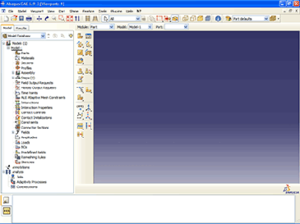LS-DYNA , developed by Livermore Software Technology Corporation (LSTC), is a multi-purpose explicit and implicit finite element and multiphysics program used to analyse the nonlinear response of structures.
Its fully automated contact analysis and wide range of material models enable users worldwide to solve complex, real-world problems.
LS-DYNA originated from the 3D
FEA program
DYNA3D, developed by Dr. John O. Hallquist at
Lawrence Livermore National Laboratory (LLNL) in 1976. DYNA3D was created in order to simulate the impact of the Full Fusing Option (FUFO) or "
Dial-a-yield" nuclear bomb for low altitude release (impact velocity of ~ 40 m/s). At the time, no 3D software was available for simulating impact, and 2D software was inadequate. Though the FUFO bomb was eventually canceled, development of DYNA3D continued.DYNA3D used explicit time integration to study nonlinear dynamic problems, with the original applications being mostly stress analysis of structures undergoing various types of impacts. The program was initially very simple largely due to the lack of adequate computational resources at the time. A two-dimensional version of the same software was developed concurrently. In 1978 the DYNA3D
source code was released into the
public domain without restrictions after a request from France.
In 1979 a new version of DYNA3D was released which was programmed for optimal performance on the
CRAY-1 supercomputers. This new release contained improved sliding interface treatment which was an order of magnitude faster than the previous contact treatment. This version also eliminated structural and higher order solid elements of the first version, while including element-wise integration of the integral difference method developed in 1974.
The 1982 release included nine additional material models which allowed for new simulations, such as explosive-structure and soil-structure interactions. The release also permitted the analysis of structural response due to
penetrating projectiles. Improvements in 1982 further boosted the execution speed by about 10 percent. Hallquist was the sole developer of DYNA3D until 1984, when he was joined by Dr. David J. Benson.
In 1986, many capabilities were added. The added features included beams, shells, rigid bodies, single surface contact, interface friction, discrete springs and dampers, optional hourglass treatments, optional exact volume integration, and
VAX/
VMS,
IBM,
UNIX,
COS operating system compatibility. At this point, DYNA3D became the first code to have a general single surface contact algorithm.
Metal forming simulation and composite analysis capabilities were added to DYNA3D in 1987. This version included changes to the shell elements, and
dynamic relaxation. The final release of DYNA3D in 1988 included several more elements and capabilities.
By 1988 LLNL had sent approximately 600
tapes containing simulation software. Hallquist had consulted for nearly 60 companies and organizations on the use of DYNA3D.
As a result, at the end of 1988 Livermore Software Technology Corporation (LSTC) was founded to continue the development of DYNA3D in a much more focused manner, resulting in LS-DYNA3D (later shortened to LS-DYNA). Releases and support for DYNA3D were thus halted. Since then, LSTC has greatly expanded the capabilities of LS-DYNA in an attempt to create a universal tool for most simulation needs.
